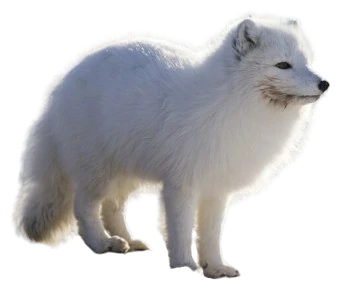
The Arctic Fox (Alopex lagopus) is a resilient canid perfectly adapted to the extreme conditions of the Arctic. It is famous for its fur that changes color with the seasons and its ability to survive in the planet's harshest environments.
The Arctic Fox is a modest-sized animal, measuring between 46 and 68 cm in length and weighing from 3 to 9 kg. Its dense, insulating fur changes from white in winter to brown in summer, allowing it to effectively camouflage in its environment. Its round head features small pointed ears and dark eyes that reflect its intelligence and adaptability.
The Arctic Fox (Alopex lagopus) belongs to the Canidae family, which also includes domestic dogs, wolves, and coyotes.
The Arctic Fox is distinct from the Red Fox, although both species share a common ancestry within the genus Alopex.
The Arctic Fox primarily lives in the cold regions of the Arctic, ranging from Canada to Greenland and Scandinavia. It inhabits tundras, icy shores, and mountainous areas, where it is well-adapted to harsh winters and short summers. In winter, it lives in burrows it digs in the snow or under rocks.
Unlike other canids, the Arctic Fox is rather solitary. It generally hunts alone and moves around in search of food. However, during the breeding season, it forms monogamous pairs and shares the tasks of building dens and guarding the young. Very territorial, it marks its domain with specific scents.
An opportunistic carnivore, the Arctic Fox primarily feeds on small mammals such as lemmings, but it can also catch birds, fish, and scavenge on carrion. In winter, it often follows larger predators, such as the Polar Wolf, to feed on leftovers. It adapts its eating habits depending on the availability of prey.
While the Arctic Fox is not currently endangered, it is vulnerable to climate change. Melting ice and the loss of its natural habitat affect its ability to hunt and reproduce. Conservation measures are necessary to protect Arctic ecosystems and prevent Arctic Fox populations from declining.
The Arctic Fox belongs to the genus Vulpes, which also includes the Red Fox (Vulpes vulpes), the Corsac Fox (Vulpes corsac), and the Fennec Fox (Vulpes zerda). These species share common characteristics, notably their small size and adaptation to specific environments.
Observing an Arctic Fox in its natural habitat can be an unforgettable experience, but it is important to respect its environment.